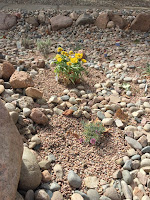By Amy Lentz, Weld County Extension
 Contrary to what you may have heard,
orchids are not difficult to grow and in most cases, they will grow in the
same conditions as your other houseplants and require a similar amount of care. With the proper amount of light, water, humidity, temperature and fertilizer, orchids can thrive! Some types of orchids such as Phalaenopsis
or Cattleya types can be easier to
care for than others and make great options for beginners.
Contrary to what you may have heard,
orchids are not difficult to grow and in most cases, they will grow in the
same conditions as your other houseplants and require a similar amount of care. With the proper amount of light, water, humidity, temperature and fertilizer, orchids can thrive! Some types of orchids such as Phalaenopsis
or Cattleya types can be easier to
care for than others and make great options for beginners.
Healthy roots are essential to the growth and health of your
orchid so the choice of growing medium plays an important role. Many orchids naturally grow in trees in the wild and these types of growing mixes mimic that natural setting. These types of orchids prefer a very porous growing medium made of materials such as bark, husks, perlite, or clay
pebbles, all of which are ideal for the roots to establish themselves and receive
adequate air movement.
 Due to the very porous nature of orchid growing mixes, water will readily flow through. You will want
to water your plants thoroughly to soak the roots and growing medium. Never let
your orchids sit in standing water because their roots need oxygen, too. One
way to accomplish a good watering is to place the plant in a sink or tub, water
it,enough to wet the medium, wait a few minutes, water it again, and repeat this until the medium is
well soaked. Make sure to drain off any excess.
Due to the very porous nature of orchid growing mixes, water will readily flow through. You will want
to water your plants thoroughly to soak the roots and growing medium. Never let
your orchids sit in standing water because their roots need oxygen, too. One
way to accomplish a good watering is to place the plant in a sink or tub, water
it,enough to wet the medium, wait a few minutes, water it again, and repeat this until the medium is
well soaked. Make sure to drain off any excess.
Orchids like to dry between watering so don’t
water too frequently. If you are unsure whether you should water again, wait a
day. You can also get a feel for how heavy the container is after watering and
if it is lighter than usual then give it a good drink! While your orchids are actively growing, fertilize
them with a houseplant or orchid formulation at a diluted rate (50%) once a
month.
Orchids prefer some humidity and one way to increase the
humidity level is to grow your plants in groups or place a dish of water nearby
to produce humidity as the water evaporates. You can also mist them but be
careful not to keep them moist for prolonged periods of time. I’ve managed to
cheat by growing mine near the kitchen sink and dishwasher.
Colorado gets over 300 days of sunshine per year which is
great for our window-bound houseplants and especially orchids. However, with
the high intensity of the sun you will need to place your orchid in indirect
sunlight to make sure they do not get sunburned. A south or west facing window
may be too intense, so placing your orchid about 2 feet away from an east
facing window is ideal. If your orchid is hesitating to flower, then you can
encourage it by relocating it to an area with higher light levels.
Room temperature is ideal so you won’t need to make any
adjustments for your orchids. They prefer temperatures between 55 and 75 °F,
so 65 to 70 °F
is perfect. Phalaenopsis types can do
well in temperatures up to 80 °F.
Orchid blooms are interesting, delicate and stunning! They can last for several weeks or even months if the plant is happy and are a great addition to you houseplant collection.
Learn more about Phalaenopsis and Cattleya orchids here:






























